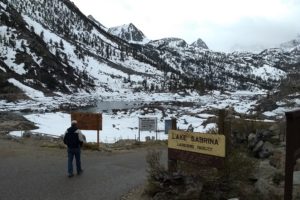As we’re exploring west along Hwy. 50, we’re ready for a fort around the time of the Pony Express, a stagecoach stop on the Carson River, and one look at the war with the Indians at Pyramid Lake.

Built in 1861, the Army’s Fort Churchill was located in this valley to protect the earliest settlers in Silver Springs, west of Fallon along the Carson River, as well as guard Pony Express mail runs and the telegraph lines. This military presence calmed the concerns of the local residents during the years and quelled uprisings coming from the Civil War. During its heyday, the fort was busy as a supply depot for other forts in northern Nevada. Adobe structures were created to house the officers and the soldiers. Even though the Fort was abandoned in 1870, the ruins have been preserved for us in arrested decay (like the ghost town of Bodie in the Other Side posts) by the Civilian Conservation Corps (CCC).

and guard shack could have looked like


Officers’ life was comfortable at the fort, and the permanence of the officers generated loyalty from the soldiers.

overview of the fort’s structures

The finished fort shown in the drawing had 21 buildings arranged in a square around the parade ground.



now the buildings

Life for enlisted men was isolated and dreary. Their dirt-floor barracks were furnished with crude beds and a few chairs. They ate a diet of beef, salt port, bread, coffee, beans and rice. Performing manual labor for only $13/month wasn’t pleasant or stimulating, far from what they had been promised when they enlisted. Recreation was limited to fishing on the river, drinking, and playing cards at the post’s traders store or Buckland’s Station.


storehouses

of the guard house to discourage stealing anything. Both were built with
20-inch think adobe walls and included an office and a large storeroom kept under lock and key. No heat sources were allowed to safeguard against fires.
Supplies kept here were for these soldiers and troops operating in other parts of northern Nevada. Supplies included salted meat, hardtack, coffee, sugar, salt, flour, vinegar, potatoes, canned foods, medicines, clothing, bedding, tents, cooking gear, lanterns, tools, and building materials.

other buildings




officers’ quarters

Adobe walls were 20 inches thick and 18 feet high. First floor ceilings were 12 feet high, while the second story ceilings were 5-1/2 feet high.
Wide porches sheltered 3 sides of the buildings, and attached to the back was a woodshed with a privy. The first floor had a parlor, 2 bedrooms, a dining room, and a kitchen with a cellar below ground.


Life for the officers stationed here was much better than for the enlisted men. Fort Churchill was considered to be a luxury assignment for these men because of their spacious living quarters, lack of real work that needed to be done, and regular arrival of mail and newspapers. Cities in western Nevada were within a few hours ride.
post cemetery

The remains of 44 unknown soldiers were removed in 1885 to a cemetery in Carson City. Weather and time left the fort’s cemetery’s headstones unreadable.

Buckland’s Station


Earliest residents in the area were Native Americans. Then came the fur trappers around 1830 and the emigrants in wagon trains in the 1840s and 1850s. One emigrant was Samuel Buckland.

When Fort Churchill was abandoned in 1869, he purchased many of the post’s buildings and used these materials to construct the large, permanent structure that is Buckland Station today.


side view of station 
another side view


the longest ride by a Pony Express rider
This plaque commemorates the longest ride by a Pony Express rider. In the spring of 1860 during the Pyramid Lake War, Robert “Pony Bob” Haslam left the Lake Tahoe station going east toward the Buckland Station. When he reached the Carson River, 60 miles into his trip, no horses were left for him since they were being used in the war. So he had to continue riding his nearly exhausted horse.

Bob’s relief rider at Buckland Station refused to ride, fearful of being attacked along the way (the only rider who ever refused to ride), so within 10 minutes, Bob got back on a horse. After passing through Carson Sink, Sand Springs, and Cold Springs, he covered 190 miles and turned the mochila over to another rider at Smith’s Creek.
After a 9-hour rest, Pony Bob received the westbound mail and started the return trip. The Cold Springs station had been raided and the shopkeeper killed; no horses were left. He had to keep riding. Legend is that Pony Bob even rode right through the middle of a group of Paiutes heading in the same direction. He finally reached Buckland Station within 3-1/2 hours of the scheduled time. Pony Bob continued to ride his route back to Friday’s Station at Lake Tahoe.
His 380-mile round trip in just 36 hours became the longest on record for the Pony Express!
In 1995, the state purchased the property and incorporated it into Fort Churchill State Historic Park, and we’re so glad they did.




